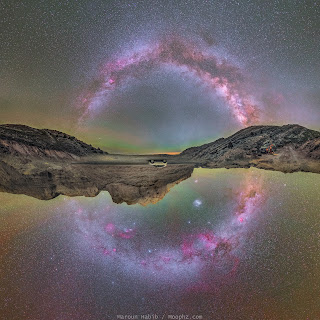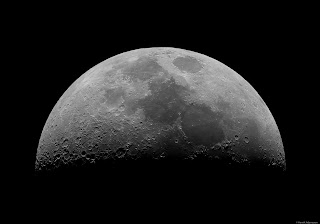These great hollow globes of artificial super-metals, and artificial transparent adamant, ranged in size from the earliest and smallest structures, which were no bigger than a very small asteroid, to spheres considerably larger than the Earth. (Olaf Stapledon, STAR MAKER)
Saturday, March 31, 2018
Twilight
Today's Astronomy Picture of the Day gathers two inner-system evening stars (Mercury and Venus) in the sky with our own Moon.
Friday, March 30, 2018
A Gathering of Galaxies
I'm not sure if a cluster of galaxies is known as a Grouping, but today's Astronomy Picture of the Day shows NGC 247 and other galaxies that can be seen in the same field of view.
Thursday, March 29, 2018
Neigh
Today's Astronomy Picture of the Day shows NGC 2023, dusy molecular clouds in the constellation of Orion. It's often overlooked due to the proximity of one of amateur astronomy's elusive targets, the Horsehead (off camera in this case).
Wednesday, March 28, 2018
There's a Bathroom on the Right
Today's Astronomy Picture of the Day shows the "blue moon" (folks, it's really not that rare or spectacular...or particularly blue!) rising near a lonely tree.
Tuesday, March 27, 2018
Monday, March 26, 2018
Gear
Saddle bag of mouse traps. 55 gallon drum of wrestling-grade chocolate pudding. Mount Palomar Observatory spare lens.
Fragment
Around the skull-hive they hover, carrying nectar from dream flowers; nectar, to smear on the sleeper's tongue, to place in her eyes.
Cluster (No Eno)
Today's Astronomy Picture of the Day shows us galaxies clustering in Coma Berenices (which, along with the Leo Cluster, makes up the Coma Supercluster—it's galaxies all the way down). How many stars? How many planets? How many other forms of life in this small field?
Sunday, March 25, 2018
Boom Today
Today's Astronomy Picture of the Day focuses in on Nova Carinae 2018, a newly discovered "rapidly expanding" star. How bright will it become? Keep watching!
Saturday, March 24, 2018
The RuneQuest Revival
It's coming! I can't wait!
But wait, there's more! You can now adventure on Glorantha using the 13th Age system as well!
And the HeroQuest Glorantha is growing as well!
Layers
Today's Astronomy Picture of the Day focuses in on NGC 602, a star cluster near the Small Magellanic Cloud. What a view! Cluster, nebula and oh so many further galaxies!
Friday, March 23, 2018
Cosmic Jellies
Today's Astronomy Picture of the Day shows Sharpless 249 and the named Jellyfish Nebula. What other nautical wonders reside in the sky?
Thursday, March 22, 2018
Spiral Dust
Today's Astronomy Picture of the Day is a wonderful shot of NGC 253, a spiral galaxy in the constellation of Sculptor. Discovered by Caroline Herschel (and you should really look up her life!), NGC 253 contains a high concentration of dust and displays an "frantic" amount of star formation. Try hunting it up with your backyard telescope!
Wednesday, March 21, 2018
Deep Look
Today's Astronomy Picture of the Day is a good demonstration of the strength of the camera vs. the strength of the eye. It's a familiar sight in the sky: Orion the Hunter. But, by allowing the camera time to gather light, we see beyond the eye and tease out some astounding detail. "Mouseover" the image in the link for a guide.
Tuesday, March 20, 2018
New York Does It Better
Today's Astronomy Picture of the Day shows Chicagohenge, the time when the city (the Earth) aligns so that it has the Sun "rise" (or "set") along the streets. Happy Equinox!
Monday, March 19, 2018
Sky Disk
Today's Astronomy Picture of the Day shows the Nebra Sky Disk, a Bronze Age artifact that seems to depict the sky, including the Pleiades. "It's origin and purpose remain a mystery."
Sunday, March 18, 2018
Two-Face
Today's Astronomy Picture of the Day is a short video showing a full lunar rotation. The Moon keeps the same "face" to us due to the rate of rotation, so getting a view of the whole body requires the help of a spacecraft such as the Lunar Reconnaissance Orbiter.
Saturday, March 17, 2018
The First Messier
Today's Astronomy Picture of the Day shows the first entry in the famous catalog of Charles Messier, popularly known as the Crab Nebula.
Friday, March 16, 2018
Maybe If You Squint?
Today's Astronomy Picture of the Day is of several separately catalogued nebula that, when combined, resemble a seagull and a duck. Can you see it? Maybe if I squint some more?
Thursday, March 15, 2018
Cataloging the Galactic Zoo
Today's Astronomy Picture of the Day focuses on humanity's need to make lists. Astronomers have long worked at cataloging the sky and here we see the initial efforts of Charles Messier (who was actually listing things that were not comets) to the New General Catalog and Index Catalog (J.L.E. Dreyer) and beyond.
Wednesday, March 14, 2018
What's Up?
Today's Astronomy Picture of the Day is a handy chart showing sky events over the next few months. Get out and look up!
Tuesday, March 13, 2018
Mirrorverse
Today's Astronomy Picture of the Day takes us around the plane of the Milky Way by combining images from the northern and southern hemispheres.
Monday, March 12, 2018
Flyover
Today's Astronomy Picture of the Day is a short video from the International Space Station. Sunrise, sunset.
Sunday, March 11, 2018
Interstellar War!
Today's Astronomy Picture of the Day is, alas, not sign of interstellar conflict. Herbig-Haro 24 in the Orion B molecular cloud complex displays opposing jets of gas from a newborn star in the nebula.
Saturday, March 10, 2018
Lunar Rhythms
Today's Astronomy Picture of the Day brings us a full set of moon phases, with a bonus eclipse thrown in for good measure.
Friday, March 9, 2018
Horsehead Closeup
Today's Astronomy Picture of the Day is a Hubble Space Telescope image of the Horsehead Nebula (Barnard 33) in the constellation of Orion.
Thursday, March 8, 2018
Cyclones
Today's Astronomy Picture of the Day brings us one of the latest images from the Juno Orbiter—polar cyclones at Jupiter!
Wednesday, March 7, 2018
Arcs, Jets and Shocks
Today's Astronomy Picture of the Day is a detailed look inside nebular complex NGC 1999. "Mouseover" the image in the link for a guide.
Tuesday, March 6, 2018
Glow
Today's Astronomy Picture of the Day shows a deep Milky Way band surrounded by glowing bands of sky. Amazing!
Monday, March 5, 2018
Deep Look
Today's Astronomy Picture of the Day shows the famous Hubble Deep Field. "Mouseover" the image in the link for not only an enlarged view but a musical accompaniment.
Sunday, March 4, 2018
Layers
Today's Astronomy Picture of the Day shows layers and layers across the sky: from furthest (Venus, then the Moon) to nearest (clouds and then birds).
Saturday, March 3, 2018
Grooves and Rilles
Today's Astronomy Picture of the Day was taken during the journey of Apollo 8 and shows features within craters in Mare Fecunditatis.
Friday, March 2, 2018
Whirling
Today's Astronomy Picture of the Day shows densely-packed star trails over the skies of the Alborz Mountains.
Thursday, March 1, 2018
Lunar Treasure
Today's Astronomy Picture of the Day is a good example of why the "mundane" Moon is such a fascinating subject of observation by amateur astronomers. As the Moon waxes and wanes throughout the month, shadows grow and shrink, features change in appearance. Along the terminator, one can seek the peaks of mountains burst into light ahead of the line of dawn, or linger in light past the line of dusk.
Subscribe to:
Posts (Atom)































